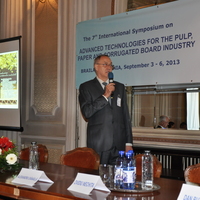Papers by Eugen Mironescu

Cell Biology International, 2010
As part of a programme of comparative measurements of P d (diffusional water permeability) the RB... more As part of a programme of comparative measurements of P d (diffusional water permeability) the RBCs (red blood cells) from an aquatic monotreme, platypus (Ornithorhynchus anatinus), and an aquatic reptile, saltwater crocodile (Crocodylus porosus) were studied. The mean diameter of platypus RBCs was estimated by light microscopy and found to be ,6.3 mm. P d was measured by using an Mn 2+-doping 1H NMR (nuclear magnetic resonance) technique. The P d (cm/s) values were relatively low: ,2.1610 23 at 25˚C, 2.5610 23 at 30˚C, 3.4610 23 at 37˚C and 4.5 at 42˚C for the platypus RBCs and ,2.8610 23 at 25˚C, 3.2610 23 at 30˚C, 4.5610 23 at 37˚C and 5.7610 23 at 42˚C for the crocodile RBCs. In parallel with the low water permeability, the E a,d (activation energy of water diffusion) was relatively high, ,35 kJ/mol. These results suggest that ''conventional'' WCPs (water channel proteins), or AQPs (aquaporins), are probably absent from the plasma membranes of RBCs from both the platypus and the saltwater crocodile.

Studia Universitatis Babeș-Bolyai. Chemia
ABSTRACT. The aim of this in vitro study was to assess dye microleakage and sealing ability of fo... more ABSTRACT. The aim of this in vitro study was to assess dye microleakage and sealing ability of four dental materials: a polycarboxilate cement (Adhesor Carbofine® - Spofa Dental), a glass ionomer cement (Kavitan Plus®- Spofa Dental), a composite resin (Core-It®- SpiDent) and a MTA based cement (MTA Fillapex®- Angelus). Forty, extracted, human teeth with single root canals were selected for this study. The teeth were randomly divided into four study groups and one control group. The root canals were instrumented and filled with gutta-percha and sealer. Root-ends were resected and 3 mm deep cavities were prepared. Root-end cavities were filled, each with a type of material. Methylene blue dye was used for determination of dye leakage. Afterwards, Scanning Electron Microscopy was used to evaluate the sealing ability of each material. Kolgorow-smirnow z test was used to determine the type of data distribution. One-way analysis of variance (ANOVA) followed by a Tukey test were used to de...





Uploads
Papers by Eugen Mironescu